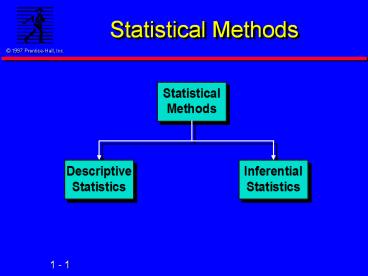Statistical Methods - PowerPoint PPT Presentation
1 / 30
Title:
Statistical Methods
Description:
Box-and-Whisker Plot. Graphical display of data using. 5-number summary. 1 - 28 ... Box-and-Whisker Plot. 1 - 29 1997 Prentice-Hall, Inc. Conclusion ... – PowerPoint PPT presentation
Number of Views:80
Avg rating:3.0/5.0
Title: Statistical Methods
1
Statistical Methods
2
Descriptive Statistics
- Involves
- Collecting data
- Presenting data
- Characterizing data
- Purpose
- Describe data
3
Inferential Statistics
Population?
- Involves
- Estimation
- Hypothesis testing
- Purpose
- Make decisions about population characteristics
4
Key Terms
- Population (universe)
- All items of interest
- Sample
- Portion of population
- Parameter
- Summary measure about population
- Statistic
- Summary measure about sample
5
Data Types
6
Data Type Examples
- Numerical
- Discrete
- To how many magazines do you subscribe currently?
___ (Number) - Continuous
- How tall are you? ___ (Inches)
- Categorical
- Do you own savings bonds? __ Yes __ No
7
How Are Data Measured?
- Nominal scale
- Ordinal scale
- Interval scale
- Ratio scale
8
Standard Notation
9
Numerical Data Properties
Central Tendency (Location)
Variation (Dispersion)
Shape
10
Numerical DataProperties Measures
11
Central Tendency
12
Mean
- Measure of central tendency
- Most common measure
- Acts as balance point
- Affected by extreme values (outliers)
- Formula (sample mean)
13
Median
- Measure of central tendency
- Middle value in ordered sequence
- If odd n, middle value of sequence
- If even n, average of 2 middle values
- Not affected by extreme values
- Position of median in sequence
14
Mode
- Measure of central tendency
- Value that occurs most often
- Not affected by extreme values
- May be no mode or several modes
- May be used for numerical categorical data
15
Quartiles
- Measure of noncentral tendency
- Split ordered data into 4 quarters
25
25
25
25
Q1
Q2
Q3
16
Summary of Central Tendency
17
Variation
18
Range
- Measure of dispersion
- Difference between largest smallest
observations - Ignores how data are distributed
19
Interquartile Range
- Measure of dispersion
- Also called midspread
- Spread in middle 50
- Not affected by extreme values
- Formula
20
Variance Standard Deviation
- Measures of dispersion
- Most common measures
- Consider how data are distributed
- Show variation about mean (X or m)
21
DISPERSION ABOUT THE MEAN
- Variance
- s2
22
DISPERSION ABOUT MEAN (cont.)
- Standard deviation (sd)
s
23
PROPERTIES OF THE STANDARD DEVIATION IN A NORMAL
CURVE
1s 68
2s 95
3s 99
24
Summary of Variation Measures
25
Shape
26
Shape
- Describes how data are distributed
- Measures of shape
- Skew Symmetry
27
Box-and-Whisker Plot
- Graphical display of data using5-number summary
28
Shape Box-and-Whisker Plot
29
Conclusion
- Explained numerical data properties
- Described summary measures
- Central tendency
- Variation
- Shape
- Analyzed numerical data using summary measures
30
This Class...
Please take a moment to answer the following
questions in writing
- What was the most important thing you learned in
class today? - What do you still have questions about?
- How can todays class be improved?































